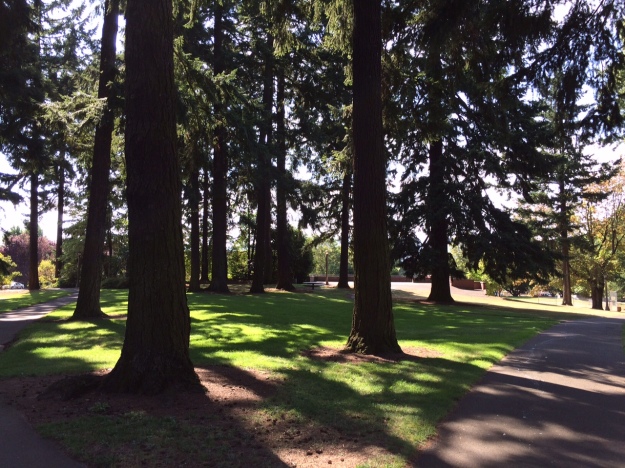
The upper portion of Duniway Park. A Nyssa sylvatica growing at the toe of the slope below OHSU. The turf is completely unirrigated, is very compacted and has poor drainage. Much of this turf is dominated by a few broad leaf weeds while most of the grasses that survive are weedy as well. The whole Park is built over one of Portland’s first dumps.
I wrote what follows a couple of years ago while still a horticulturist with Portland Parks and Recreation. It was an addendum to a piece I wrote addressing a different approach for prioritizing work in Park landscapes and is reproduced here, with slight changes, as i originally wrote it. I thought of it more recently as I’ve watched Portland bake this summer and observed, consequently, the decline of residential and Parks lawns. I am a big proponent of ‘sustainable’ landscapes. That does not prevent me from seeing the necessity for grass lawns in urban areas especially in cities as they follow the path to increased density for sustainability issues as well. People ‘need’ open space and as we all ‘suffer’ from our own shrinking of private outdoor space, the need for such public spaces increases. But turf cannot fill the need if it is poorly maintained. Dormant, dry, compacted weed dominated lawns are both unattractive and less functional. Open spaces are not all the same. Ugliness can degrade them to the point of rendering them almost useless in terms of their human value (We often speak of habitat value for wildlife and in terms of water quality. We spend less public time discussing what is of basic human value. What we require to meet our very real and ‘animal’ needs. Not all of our legitimate needs can be met by buying products and services.)
Vigorous grass based turf is not sustainable. It is a monoculture susceptible to weed invasion that requires regular care, including, irrigation, mowing, fertilization, aeration to reduce compaction, occasional dethatching, control of moles and, for the best stands, the occasional well timed application of an herbicide and insecticide. Having said this, I still see it as a vital component of our Parks. Portland Parks and Recreation has other priorities making exceptions Park by Park, though select athletic fields for playability and safety reasons are still irrigated. (Other Parks Districts, notably places like Bend, OR, with a desert environment, have prioritized having good quality turf in public areas). No other surface provides the functionality and value of turf grass in an urban environment. It absorbs rainfall; reduces the problems of mud and dust and helps control the erosion that accompanies bare soil; provides a firm, but shock absorbing surface for activities; aids with cooling the urban heat island; provides a restful carpet of green that helps calm a potentially chaotic visual world; and, provides a surface for young children to play on or family and friends to relax or picnic on. As urban density increases, the need for public open space increases. We need lawn. Concrete, pavers and asphalt will never fill all of this need. An argument can easily be made that rich healthy lawns better fill this human need when they are in Parks than scattered thinly through residential neighborhoods in front and backyards where they are individually too small or inaccessible to meet the public need. Continue reading →






